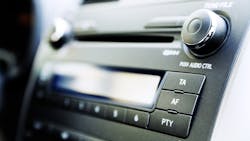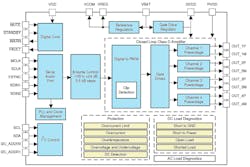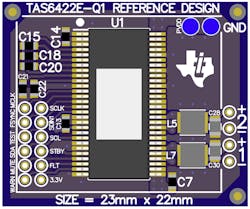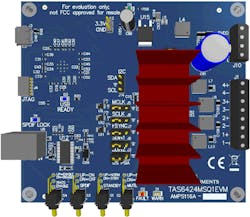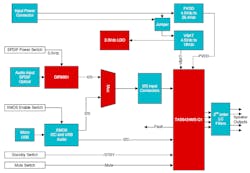Automotive Audio Amp Packs Power, Features, Functions—and Protection
With all of the attention on ADAS functionality, smart cars, and even fully or semi-autonomous vehicles, it’s easy to overlook the importance of high-performance audio as part of the vehicle’s total infotainment package. We’ve certainly come a long way from just a basic Class-D audio amplifier, as demonstrated by the Texas Instruments TAS6424MS-Q1, a multichannel digital input, Class-D audio amplifier that can used as an external amplifier or in the head unit (Fig. 1). It’s AEC-Q100-qualified (temperature grade 1: −40 to +125°C ambient temperature) and meets CISPR25-L5 EMC specifications, essential for the automotive market.
The IC, which comes with a comprehensive 75-page datasheet, can be configured for a four-channel bridge-tied load (BTL) or two-channel parallel BTL (PBTL) operation. It delivers up 27 W into 4 Ω at 14.4 V (BTL), 45 W into 2 Ω at 14.4 V (BTL), or 80 W into 2 Ω at 18 V (PBTL), all at 10% THD. At the other end of the power range, THD+N is below 0.02% at 1 W, with just 42 µVRMS output noise driving a 4-Ω load in the 14.4 V BTL configuration.
On the audio-input side, it handles four-channel I2S or 4/8-channel TDM inputs, with input sampling rates of 44.1, 48, and 96 kHz along with 16- to 32-bit I2S, and TDM input formats. It requires a minimum of external components for operation as shown by its basic reference-design PCB (Fig. 2).
Of course, the automotive market has other unique requirements. Specific to the needs of cars and AM broadcast-band radio (yes, many—but not all—cars still offer that capability), the output switching frequency can be set either above the AM band, which eliminates interference in the AM band and reduces output-filtering needs and cost, or it can be set below the AM band to optimize efficiency.
In the harsh world of automotive installations and operation, bad things happen, so the device has a variety of diagnostic and protection features. These include the ability to detect output-open and shorted-load conditions as well as output-to-battery or ground shorts. Protection considerations encompass output-current limiting and output-short protection, 40-V load-dump tolerance, open-ground and open-power tolerance, and overtemperature, undervoltage, and overvoltage situations.
Design-in support includes the standalone TAS6424MSQ1EVM evaluation module (Figs. 3 and 4), which has single power-supply input, USB control via the TI PurePath Control Console 3, and two I2S audio-input options. It’s supported by a 38-page datasheet that also demonstrates the software functions and operation.
The TAS6424MS-Q1 is housed in a 56-lead HSSOP package measuring about 18.4 × 7.5 mm and operates from a 4.5- to 18-V supply voltage. Operation at that low-end voltage is needed to ensure the IC and thus audio infotainment continues to function without interruption during the battery “droop,” which occurs in vehicles using the engine-start/stop fuel-saving “feature.”
About the Author

Bill Schweber
Contributing Editor
Bill Schweber is an electronics engineer who has written three textbooks on electronic communications systems, as well as hundreds of technical articles, opinion columns, and product features. In past roles, he worked as a technical website manager for multiple topic-specific sites for EE Times, as well as both the Executive Editor and Analog Editor at EDN.
At Analog Devices Inc., Bill was in marketing communications (public relations). As a result, he has been on both sides of the technical PR function, presenting company products, stories, and messages to the media and also as the recipient of these.
Prior to the MarCom role at Analog, Bill was associate editor of their respected technical journal and worked in their product marketing and applications engineering groups. Before those roles, he was at Instron Corp., doing hands-on analog- and power-circuit design and systems integration for materials-testing machine controls.
Bill has an MSEE (Univ. of Mass) and BSEE (Columbia Univ.), is a Registered Professional Engineer, and holds an Advanced Class amateur radio license. He has also planned, written, and presented online courses on a variety of engineering topics, including MOSFET basics, ADC selection, and driving LEDs.
